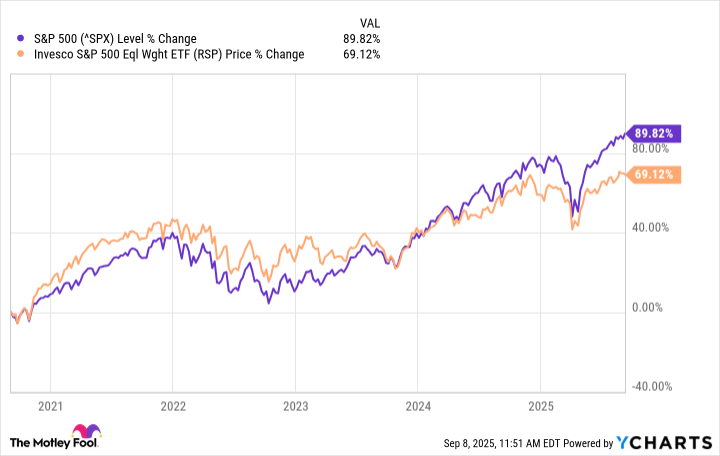Composed of roughly 500 of the most well-known large-cap U.S. stocks, the S&P 500 index is a benchmark for the entire market, which is why so many investors choose to own the index in one way or another. Over many decades, it can be very difficult for investors to outperform the broader market with their own investing strategies.
And over the past five years, the S&P 500 has seen particularly strong returns, nearly doubling in that period. That said, it has also been very volatile while operating under conditions that have made it difficult for investors to properly value the market or determine its ceiling. Given the uncertainty, here's the best way to invest in the S&P 500 in September.

Image source: Getty Images.
How we got here
The S&P 500 has been hitting new all-time highs for several years now. The momentum is being driven by a small group of large technology stocks investing heavily in artificial intelligence. These companies, known as the "Magnificent Seven," make a tremendous amount of money and are believed to be the primary beneficiaries of the AI tailwind, which is why they are investing hundreds of billions into AI-related capital expenditures. Most of their market caps have now surpassed $1 trillion, while the AI chip giant Nvidia has a market cap of over $4 trillion.
Due to their incredible size, these seven companies make up over 30% of the S&P 500. On one hand, this concentration has contributed to the S&P 500's outperformance. On the other hand, many investors are concerned by big tech's premium valuations and what might happen to the broader market if the AI revolution stumbles and takes this group of stocks down with it. Even the S&P 500 is trading at an above-average forward price-to-earnings (P/E) ratio of 23.
That's not to say investors are wrong to be bullish on AI, but just as the internet changed the world, the markets had to survive the dot-com bubble first. The internet and AI booms are different in many regards, but there are enough similarities to put some people on high alert.
The best way to invest in the S&P 500
Considering the dynamics mentioned above, the smartest way to invest in the broader benchmark this month, in my opinion, is to actually buy the Invesco S&P 500 Equal Weight ETF (RSP -0.49%). As the name suggests, this index removes the market cap weighting used by the S&P 500, so investors will have equal exposure to all companies in the index. In doing so, investors remove the concentration risk posed by the Magnificent Seven.
Data by YCharts.
Over the past five years, the standard S&P 500 has outperformed the equal-weight S&P 500, driven by tech and AI. The Invesco ETF isn't likely to outperform the S&P 500 in the near term, but it could certainly limit investors' downside if the market takes a turn for the worse. And if investors broaden their focus beyond the index's biggest names, the equal-weight index fund may also outperform. Currently, the Invesco ETF trades at a forward P/E ratio of about 18, so it's also much cheaper than the benchmark index.
Now, more aggressive investors with a long-term horizon can certainly still invest in the S&P 500, as long as they are prepared for more volatility. The market has experienced many crashes and recessions, but it has gone on to reach new highs while generating strong returns for investors. If you do continue to buy ETFs tracking the S&P 500, consider dollar-cost averaging, which should smooth out your cost basis over time.
But if you're primarily looking for the best way to buy the S&P 500 right now, I still like the Invesco S&P 500 Equal Weight ETF, given where valuations are and the looming uncertainty around monetary policy and the economy.






